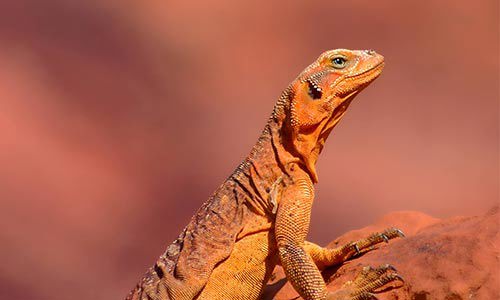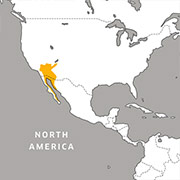Appearance:
Male chuckwallas are larger than females, and they have a rusty coloration while their head and limbs remain black. Females retain their juvenile coloration of grayish-yellow. This coloring provides chuckwallas with camouflage from predators.
They have small, coarse scales and a sandpaper-like texture. Their tails are thick at the base and taper at the end. Unlike females, males have pores on the inside of their legs.
Size:
- Weight:
- Adult: 24 to 315 grams
- Neonate: 6 to 9.6 g
- Length: 80 to 197 millimeters; average snout to vent length: 162 millimeters
Diet:
Chuckwallas eat leaves, fruit and occasionally insects.
Reproduction:
Chuckwallas reach sexual maturity by 1 to 3 years of age. They mate in the spring and nest in the summer. Males compete for the right to mate with females by head-butting and biting one another. Females produce between five and 16 eggs every other year. The clutch is laid in an underground nest while the female incubates her eggs. There is no parental care once eggs hatch.
Social Structure:
This species is solitary except during the breeding season.
Behavior:
Chuckwallas are diurnal, meaning they’re most active during the day. They spend their days burrowing, looking for food, and basking. Lizards can reach basking temperatures of 105°F. During the winter months, a chuckwalla will brumate in underground burrows, meaning it enters a state of inactivity to conserve energy, similar to how mammals hibernate.
A chuckwalla can store water in lymph sacs beneath skin folds on the sides of its body. Its tail will enlarge when resources are plentiful. When threatened, chuckwallas can inflate their lungs and expand their skin like a balloon so predators aren’t able to pull them from their burrow.
Communication:
Chuckwallas use color and physical displays including head bobbing, push-ups and mouth gaping to defend their territory.
Habitat/Range:
This species can be found in Southeastern California, Southern Nevada, Southwestern Utah, western Arizona, northwestern Mexico, and around the Gulf of California. Chuckwallas can live at sea level to 4,500 feet in elevation. They prefer rocky desert habitats with abundant places to hide and vegetation to eat.
Median Life Expectancy:
About 15 years in the wild
Threats:
Habitat destruction and the pet trade





